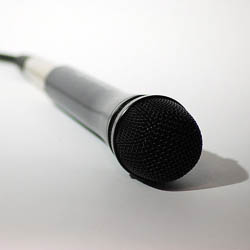
MANDOLIN, BOUZOUKI, RESONATOR GUITAR, LAP DULCIMER
• Place a flat condenser mic about 6 to 8 inches away from an f-hole or sound hole.
• Mount a mini mic near an f-hole.
HAMMERED DULCIMER
• Place a flat condenser mic about 12 inches above the top edge aiming at the soundboard.
• Tape a mini mic onto the top surface.
ACOUSTIC BASS
• Place a flat condenser a few inches in front of and above the bridge.
• Tape a mini mic to the bridge.
• Place a flat condenser a few inches in front of and below the bridge. Mix it with another flat condenser aiming at the plucking fingers.
• For isolation and mobility, wrap a cardioid dynamic mic in foam (except for the front grille) and stuff it behind the tailpiece, aiming up. Apply EQ as needed.
BRASS
• Place a flat condenser, flat dynamic or ribbon mic about 1 to 3 feet out front. Mike on-axis to the bell for a bright, edgy tone; mike off-axis to the bell for a mellower tone.
• Tape a boundary mic to the wall or to the control-room window.
WOODWINDS
• Place a flat condenser about 12 inches from the tone holes.
• Rubber-band a mic clip onto the instrument in the center. Position a mini mic a few inches from the center of the sound column.
FLUTE
• Place a flat condenser halfway between the mouthpiece and the tone holes, about 6 to 12 inches away.
• Tape the cable of a mini mic halfway betwen the mouthpiece and the tone holes. Extend the mini mic about 1 inch above the flute.
HARMONICA
• Place a flat condenser mic or mini mic 8 inches away.
• For a dirty, bluesy sound, mike up close with a handheld cardioid dynamic mic. Or plug a handheld mic into a guitar amp, and mike the amp.
HARP
• Aim a flat condenser mic at the soundboard about 18 inches away.
• Tape a mini mic to the sound board. Experiment with placement near a sound hole to get more bass.
BAGPIPE
• Mike the chanter about 8 to 12 inches from the fingers with a flat condenser mic or mini mic. Mike the drone pipes overhead with a flat condenser mic or mini mic.
ACCORDION, CONCERTINA
• For recording, place a flat condenser mic (or two for stereo) about 12-18 inches out front.
• For PA, tape a mini omni mic onto the tone holes on each side (two mics total). Or tape the cable of each mini mic to the top so that each mic hangs down over the tone holes.
• For PA, rubber-band a mini omni mic onto each wrist.
OPERA, MUSICALS
• Use two or three unidirectional boundary mics on the stage floor, in a line about one foot from the edge of the stage. Also try omni boundary mics such as PZMs.
While this guide may seem comprehensive it is but a brief starting point. You can use nearly any mic or placement on any instrument if it sounds good to you. So, actively try out new placements and invent your own techniques!
AES and SynAudCon member Bruce Bartlett is a recording engineer, audio journalist, and microphone engineer. His latest books are “Practical Recording Techniques 5th Ed.” and “Recording Music On Location.”
More articles by Bruce Bartlett on PSW:
Recording Microphone Techniques To Produce Warm, Spacious Stereo
Remastering Jazz Classics: The Dave Brubeck Quartet, Art Pepper, and Sonny Rollins
Deconstructing Hip-Hop To Hear How The Mix Comes Together
